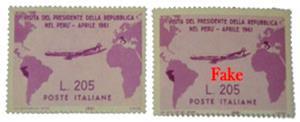Database of stamps’ inks and glues will help philatelic detectives hunt down fakes

Italian scientists have uncovered a new dimension to the art of stamp collecting by analysing the paper composition of the entire issue of Italian postage stamps of the last 150 years. Using spectral analysis, the team have assembled a database charting the evolution of the stamps’ materials in this phase of Italian postal history. With the aid of such a chronological library collectors can date any stamp from this period and detect counterfeits.
As with most artwork collections, the value of stamps is not only tied to their condition but also to their authenticity. The study of stamps – otherwise known as philately – is thus often subject to the same problems of conservation, restoration and counterfeiting associated with the art world. Ludovico Valli and his team at the Universita del Salento, Italy, believe their database of over 180 stamps reveals another aspect in the heritage of the stamp. ‘It will allow us to compare the Italian collection of stamps with others all around the world and it is for now one of the most powerful and certain tools against forgery,’ he explains.
Key to assembling their database was Fourier transform infrared (FT-IR) spectroscopy in attenuated total reflectance mode. Unlike traditional validation methods such as optical microscopy, FT-IR offers a simple, precise and immediate way to analyse the chemical composition of the stamps. More importantly, FT-IR is non-destructive and circumvents the need for special preparation of the stamps.
Its appeal to museums, collectors and sellers alike is obvious then, especially in finding the fakes from the genuine article. One case solved by the team is that of the Gronchi Rosa, among Italy’s most famous stamps. ‘The Gronchi Rosa of 1961 has proven to be fake because of the absence of the kaolin component in the ink colour found in the original exemplars,’ Valli says.
But Robin Clark at University College London, UK, says that, while useful in philatelic studies, the database is not entirely foolproof as not all the components are detectable with FT-IR alone. According to Clark, Raman microscopy is quicker and more precise in making identifications of micrometre-sized particles. ‘Raman microscopy is the most highly effective technique for identifying pigments, pigment mixtures and other components of postage stamps,’ he concludes.
Valli agrees that other spectroscopic analysis needs to be done to complement their existing database. Likewise he hopes that expanding their library to include other components such as the pigments and postmark ink will uncover further hidden secrets in the world of stamp collecting.









No comments yet